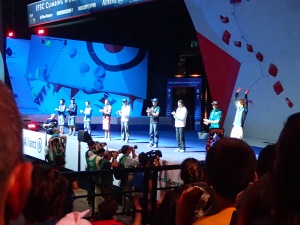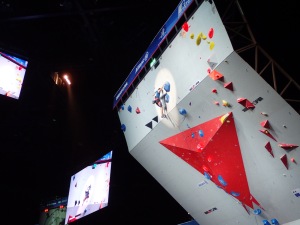Let me preface all this by saying it is a tremendous honour and privilege to represent the USA in climbing competitions. The point of this post is start a dialogue about this, not express sour-grapes, or whatever the saying is.
As many people know though, my relationship with paraclimbing competitions is frustrating at times. In Paris, it was a lot of the time. I wrote down some thoughts about this right after the competition. What should “paraclimbing” be? Should it be a measure of how climbers with a “disability” (not all paraclimbers do) climb in absolute grades, or a measure of how paraclimbers have been able to overcome and accommodate their physical deficits?
On the one hand I feel very strongly about people not looking down upon paraclimbing as if we are not athletes who train hard. I may not be able to climb 5.14s in my sleep, but I am still a pretty darn good climber by any “normal” person’s standards. Sure, there are some people at the competitions who just to show up and enjoy the experience. There are others who take it a lot more seriously. The venue for the Paris competition was amazing, and the crowds were brilliant. However, I was quite upset at over a number of things related to placing climbers in their categories and route-setting.
Categorizing the climbers
The main principle needs to be to group people as “fairly” as possible, grouping each person by the impact of their deficit on their ability to climb. This could be done by replacing or augmenting the medical check-in with a quick test of abilities, maybe guided by a questionnaire which is completed before the medical check-in. Furthermore, each agreed-upon category needs to stay open; closing out categories (e.g., combining RP-2 and RP-3 (I was placed in RP-3 who had climbers with no discernible physical limitations climbing, when by the official IFSC characterizations, I should have been placed in RP-2) before all climbers have checked in should not be done. Combining categories should be done only as a last resort; at IFSC Paris 2016, RP-2 and RP-3 climbers were put into the same categories, which is no more appropriate than combining B(lind)-1 and B-2. Finally, a reasonable level of deficit needs to be set. The definition of being disabled for paraclimbing competitions is a 5% reduction in ability. What the fuck does that mean? 5% “less” is me after a bad night of sleep. For example, is a 5% deficit in strength a “disability” or just “normal” variation? What about a 5% deficit in motor control? What if person has both deficits? Another example might be a wholly missing limb vs a partly missing limb vs a shortened limb; are these categories defined well? The point is to be fair about how people are grouped.
Objectives of route-setting
For my first qualifying route, a number of competitors (other than myself) could not even get off the ground. That was how ridiculous the setting was. This is not a bouldering competition. A well-set route-climbing competition route will get progressively harder to separate people out, not shut them down at the very beginning. The objective of route-setting in paraclimbing is not to eliminate the “weakest” at the start of the route, but to present greater and greater challenges to weed out people based on the extent to which they have overcome their disability. For example, it is not appropriate to single out people who don’t have the use of the right arm, and then set routes with widely-spaced holds that trend sharply to the right. Should the objective be to measure how well adaptive climbers have adapted: how much skill have they developed, how much strength, how much stamina?
Setting the routes
Setting routes for paraclimbers is not the same as setting routes for fully able-bodied climbers. In particular, setting routes that have difficult sections with a single way to climb them is not appropriate(**). Whereas most able-bodied climbers are pretty much the same, this is not true of paraclimbers who, for example, can be very “asymmetric” (think single-limb lower- or upper-limb amputees, spinal injuries that affect a single side, etc). Para-climbing routes need to have options, especially at the most difficult points. For example, one thing that could be done is to set routes with “mirror images” at crux sections so that climbers can choose a route that runs either left or right based on their asymmetries. Of course, each direction should be equally difficult. I recognize the route-setting is a highly creative craft and that there will always be subjectivity involved, but there are additional measures of “fairness” that need to be taken into account when setting for paraclimbers.
(**) In my case, both qualifying routes involved mandatory use of a high left foot. Usually I can find a workaround, but in these routes, there was absolutely no other way to get beyond a certain point without full use of your left leg. Or both legs for that matter. Which a number of women in the category I was competing in did have.







